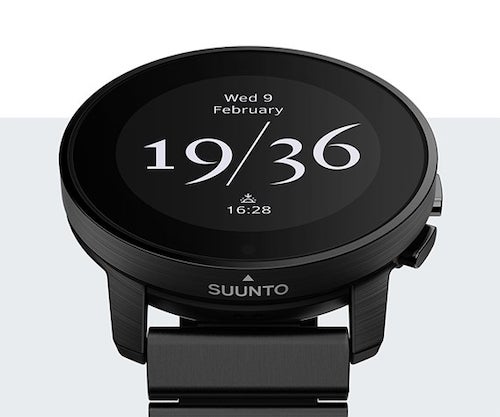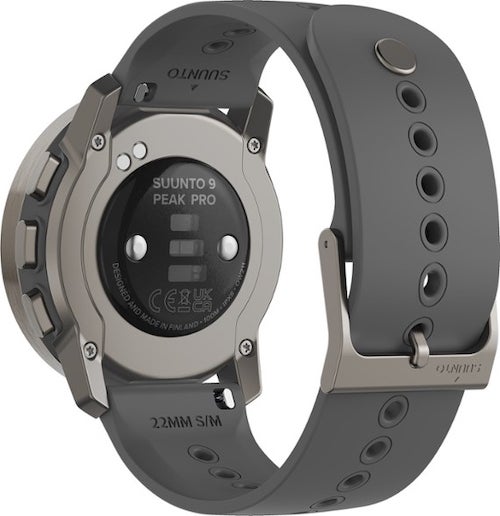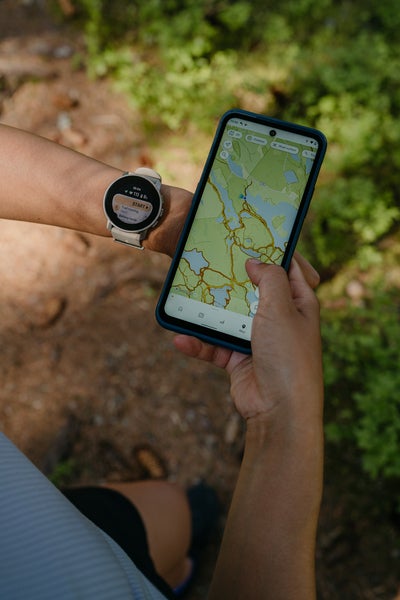New perk! Get after it with local recommendations just for you. Discover nearby events, routes out your door, and hidden gems when you sign up for the Local Running Drop.

Suunto 9 Peak Pro Review: What We Loved
My first GPS smartwatch was the Suunto 9 Baro, recommended to me by some of the nerdiest tech junkies in the endurance world, and I was immediately blown away by its performance. My jump from Casio to Suunto was like going from my dad’s Coleman canoe to a jet-powered hydroplane.
I’ve been a Suunto fan ever since, but not without significant departures to try other watchmakers. In October 2022, when Suunto launched their new 9 Peak Pro, I was curious how much more firepower they could possibly squeeze into a watch being promoted as slimmer than the 9 Peak (imagine the thickness of seven pennies). Its minimal construction appealed to me, as my Suunto 9 Baro sometimes felt like I’d duct taped an iPad onto my wrist, but I was skeptical. Luckily, the 9 Peak Pro delivered on nearly every level.
Watch Face
Starting with its outer optics, the sapphire glass is scratch-free and extremely durable. I tried stress-testing the glass and watch on a recent jungle mountain 50K in northern Thailand, with several bamboo bushwhacking sections and failed stream crossings. Zero blemishes. (Note: I have the Titanium Slate version). They also offer several snazzy new clock formats that I’ve been experimenting with.

Battery Life
Next, the battery life is a solid upgrade from the Suunto 9 (launched in June 2018) and the Suunto 9 Peak (launched in June 2021). For comparison, my Suunto 9 Baro is rated to 25-, 40-, and 120-hours when the GPS reading is set to one-, 60-, and 120-second intervals. The new 9 Peak Pro offers a rating of 40-, 70-, and 300-hours at equivalent intervals, which results in a major leap in efficiency.
That said, Garmin’s Enduro 2 boasts 81 hours in full multi-band mode and 150 hours in GPS-only (but costs nearly $1,000!), while Coros’s Apex 2 Pro offers 75 hours at full GPS (at half the cost of Garmin’s Enduro 2). Nonetheless, 9 Peak Pro’s extended battery life is an improvement from even its predecessor, the 9 Peak. With this “Pro” version, you can now go 21 days with regular use before ever needing a charge. For further comparison in this price range, the Garmin Forerunner 955 goes 15 days, and the full-size Fenix 7 goes 18. That’s significant.
In-Watch Navigation
What’s also significant is what’s inside the watch. When you touch the buttons or screen to navigate, everything just seems to move sharper and snappier. It’s as if my 9 Baro had been drinking decaf this whole time while the 9 Peak Pro is pulling quad shots of espresso. The difference is mainly a result of innovations with its new chipset, a major upgrade from the 9 Peak. This is convenient and comes in handy when you’ve got cold hands, or are turned around and need to navigate an uploaded map file, or must change a song in the watch’s media player.
Activity Modes
Speaking of activities, the 9 Peak Pro offers 95 sport activities from which to choose. I’ve probably only used five of these activities and their pre-engineered dashboards so far, but who’s to say I won’t someday get into nordic walking or mermaiding? Hell, you can track your snorkeling freedive to depths of 10 meters (waterproof up to 100 meters) with functional GPS. Plus, I’m pretty sure “fishing” as an activity option, which I’m looking forward to posting on Strava soon. Local legends, watch out. Fortunately, these activity outliers won’t bog you down because the list updates based on most-used activities. And of course, triathletes rejoice, as the Peak Pro has open-water swimming, lap swimming, cycling, running (with power; more on that below), and triathlon and in-activity-swappable multisport mode (for brick workouts or swimrun).
Ease of Use
Setting up my 9 Peak Pro with the Suunto App (which isn’t great; more on that below) and syncing it up with Strava took mere minutes. From receiving the watch to hitting trails to logging miles, this watch has thrown very few curveballs at me from the gun. Reliable, durable, and stylish, I have had multiple friends – both runners and non-runners alike – comment on its aesthetic.
Minimal-Sleek
The suave construction of the 9 Peak Pro might be its most noticeable upgrade. At 10.8 mm thick and weighing 55 grams, the watch’s thin body is most refreshing. (For comparison, my Suunto 9 Baro was 15.4 mm thick and weighs 81 grams; Garmin’s Fenix 7 42mm is 79g). With my upgrade, Suunto somehow shaved a third of its weight and nearly 5 mm of its density, while also making it more powerful on every level. Excuse me?
On-Wrist Running With Power
Two years ago, Polar and Coros were two of the only brands with on-wrist running with power, but in less than four months, both Suunto and Garmin have now joined their ranks. And just before that, the big one: In June, Apple added on-wrist running with power for iOS 9 (compatible with Watch 4 and higher).
For those who aren’t familiar, power measurement while running helps measure (or rather closely estimate) how much work you’re actually doing while running—using a crazy set of calculations based on ground contact time, weight, grade, and more. The result is a way to more objectively tell how hard you’re working, especially uphill and especially on uneven ground when min/mile pace isn’t particularly helpful. The other side of this is—unlike heart rate—power doesn’t care how you’re feeling or how many carmel macchiatos you had that morning. It can also be used to indicate efficiency on flat, measured terrain, like a track: lower power at the same speed/heart rate? That’s a good thing. Suunto no longer having to rely on shoe-based power meters like the Stryd means you’ll save some cash and be more likely to use power on your next run. Win.
RELATED: Why (And How) to Run with a Power Meter

Suunto 9 Peak Pro Review: What Could Be Improved
Charging Port
The first thing I noticed that felt unremarkable was its charging port. A similar disc-style construction comes with the 9 Peak, too, but I’m not totally sold. Instead of a small magnetic bar of the 9 Baro that snaps firmly into place, the 9 Peak Pro’s charging port is instead a plastic circle that snaps loosely to the bottom of the watch. Several times I had to rotate it at length to get it to connect, even though the charger can, allegedly, attach to the watch from all directions. It charges fast, though, I’ll give it that. In one hour you can go from empty to full. Still, I prefer the satisfying connection of my 9 Baro. The battery life is so good, though, I’ve only had to charge my 9 Peak Pro a handful of times. I recently ran a 24-hour race and never once thought about charging the watch. Major win.
Wristband
This is a small thing, but the previous model’s latching system felt more secure with its larger, lateral tooth, as opposed to the 9 Peak Pro (Titanium version; different strap) that offers only a small metal knob to punch through a thin column of holes. Though I haven’t sampled all the 9 Peak Pro straps, I don’t much like their forest green textile option, either. All 6 variations of the 9 Peak Pro come with their own color scheme and band style, which I found confusing. What is neat is that you have the option to fully customize your own watch model and strap material, even add a personalized engraving on the back. Had I known about the engraving, I would’ve most certainly added: “Gone Fishing!”

Suunto App
This is a small rub because, really, the more bells and whistles Suunto adds to their mobile device app, the more I’ll spend tinkering around on it. Suunto’s app interface isn’t much to write home about. I like their 3D route replays, sure, but there’s really no added benefit to the app if you’re already using something like Strava. It also seems to take longer to upload activities than other watches. My Coros Apex Pro, for example, uploads workouts lightning-fast. You’d think that, with such a steep price point, there’d be an application that meets the high performance of Suunto’s hardware, but this is just not the case, yet. (Suunto apparently has something up their sleeve with an update.)
Suunto 9 Peak Pro Review: Summary
Handcrafted in Vantaa, Finland, since 1937, Suunto is clearly doubling down on one thing: excellence. Not cutting corners. No flash-in-the-pan bells or whistles. No spinning navigation knobs or unnecessary flare. It’s become a tool in my endurance quiver that shows up and does its job under any circumstances.
A final thing to note, and something that sets them apart from other GPS watch manufacturers, is their commitment to the planet. Suunto uses 100% renewable energy at their Finland headquarters, enabling zero emissions in 2021. They’ve started a “Life Cycle Assessment” (LCA) for each watch produced to calculate the product’s CO2 footprint, and pledges to compensate each new Suunto 9 Peak and 9 Peak Pro’s carbon contribution with Verified Carbon Units.
And so, with an ecologically-forward business model, Suunto has achieved something remarkable with the 9 Peak Pro: a stylishly minimal, superpowered watch able to withstand a category 5 hurricane at a fraction of the weight (but, er, double the price) of most other GPS watches. Investing in a smartwatch at this price may feel like a stretch, but it’ll serve you long into the future for all your epic mountain adventures, keeping you focused less on the tech, less on the metrics, and more on what you love doing most.